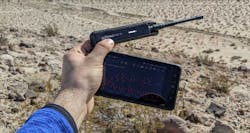Air Force to help goTenna improve military mesh network radio communications with encryption security
HANSCOM AIR FORCE BASE, Mass. – U.S. Air Force navigation and guidance experts needed next-generation mesh network radio technology. They found a solution from goTenna Inc. in Jersey City, N.J.
Officials of the Air Force Life Cycle Management Center's Theater Battle Control Division at Hanscom Air Force Base, Mass., announced a $15 million contract to goTenna in July to design and build a next-generation small, lightweight, affordable, and efficient radio capability (Pro X3) to expand overall Pro X series capabilities.
Tactical communications that enable mission-critical command and control down to the individual operator in hostile and austere environments.
The company's Aspen Grove mesh networking protocol provides long-range, short-burst, low-SWaP mobile mesh networking. Aspen Grove’s zero-control-packet approach is efficient and scalable at low bit rates.
The key benefits of the Aspen Grove protocol stack apply to many types of wireless or wired communications. Today, Aspen Grove is implemented in the goTenna's Pro X Series products to promote the scalable distribution of low-bandwidth information.
These data types include SMS, PLI, map objects, voice messages, low-resolution images, and sensor information. The company's Pro X2 system functions as a stand-alone relay can pair with a mobile phone.
The mesh network delivers mission-critical situational awareness beyond the edge of traditional connectivity. It is tested to distances as far as 15 miles line-of-sight with a standard body-mounted configuration.
Elevated ground gives the Pro X2 a range of 55 miles line-of-sight; 164.8 miles ridgeline-to-ridgeline; 130.5 miles air-to-ground using an aerial relay with a coverage.
The Pro X2 uses short burst transmissions, frequency hopping, and Aspen Grove Mesh Network protocols. It can share location and messages, and with the goTennaATAK plugin. It also uses AES 256-bit encryption, and has a battery life of nine hours per charge.
The Pro X2 meets the ruggedization guidelines of MIL-STD-810, weighs 3.5 ounces, and can deploy off-grid networks in minutes, company officials say.
On this contract goTenna will do the work in Jersey City, N.J., and should be finished by July 2026. For more information contact goTenna online at https://gotenna.com, or the Air Force Life Cycle Management Center at www.aflcmc.af.mil.
About the Author
John Keller
Editor-in-Chief
John Keller is the Editor-in-Chief, Military & Aerospace Electronics Magazine--provides extensive coverage and analysis of enabling electronics and optoelectronic technologies in military, space and commercial aviation applications. John has been a member of the Military & Aerospace Electronics staff since 1989 and chief editor since 1995.
